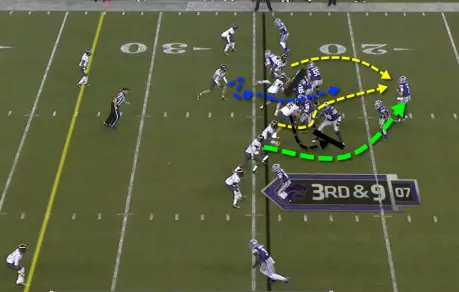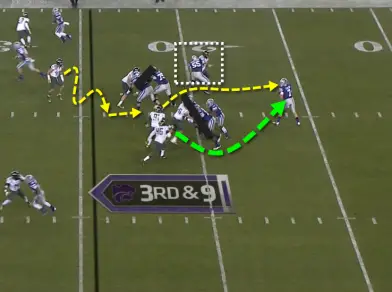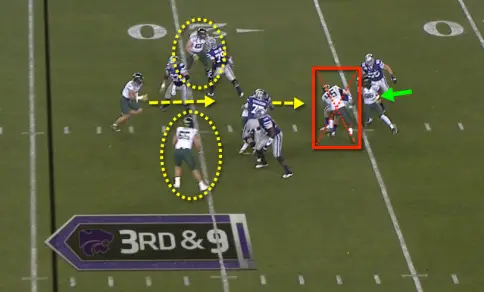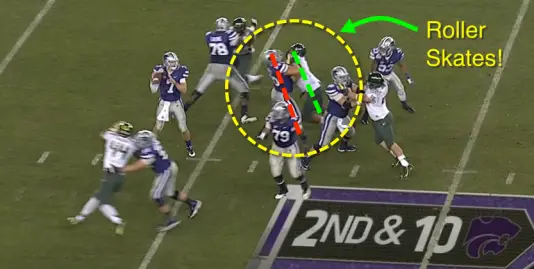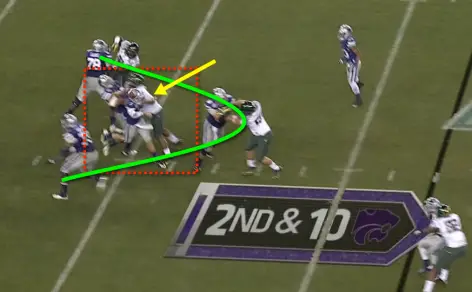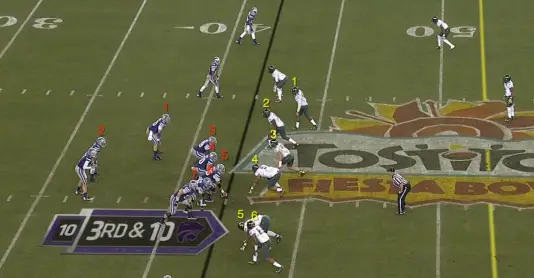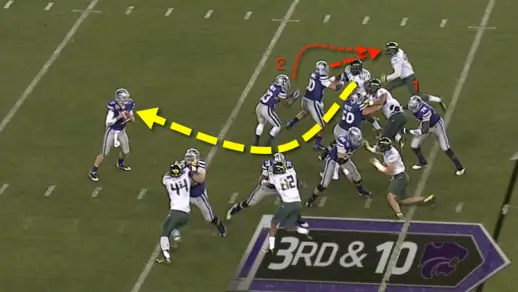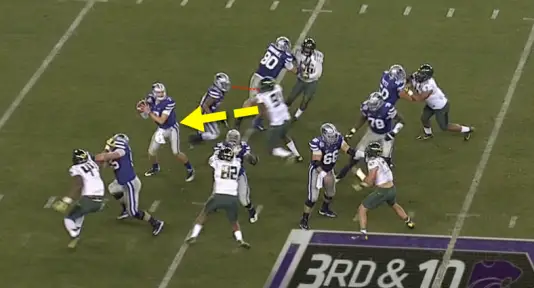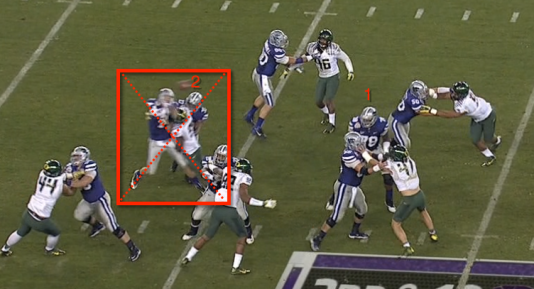Early in the Fiesta Bowl, Collin Klein and the Kansas State offense had success with short throws to help put together some lengthy drives. My article last week described how the Duck defense stuffed the K-State option game when it counted in the first half, helping Oregon score three unanswered times to build a comfortable lead. Once the Ducks began piling on points, K-State was forced to look for more plays down the field.
But whenever Klein tried to buy extra time to find space deeper in the secondary, the Ducks’ attacking zone blitz package was able to make him pay, or throw it away.
The proof?
i) Klein’s longest completion? 21 yards, on a catch-and-run by former Duck Chris Harper, after a short throw to the flat and a missed tackle.
ii) Number of his completions that traveled more than 10 yards? Zero. Nada. Zilch.
What’s the explanation for this? As Charles and I have detailed in tutorials on the Fire Zone Blitz, the Inside and Corner Zone Blitz, and the bizarre Times Square Zone Blitz, the Oregon Hybrid 3-4 defense thrives on bringing unpredictable pressure, giving quarterbacks little time to throw deep. Let’s see how the Ducks did it against K-State.
Look above. At the snap, the Ducks show a pressure package I’ll call the Five Plus One Zone Blitz. Our “front four” – nose guard and defensive tackle (black arrows/bars), both defensive ends (yellow arrows) – all rush the quarterback, as does Michael Clay (green arrow), around the outside. Kiko Alonso (blue arrow) is in man-on-man coverage with the tailback. Kiko checks to make sure the tailback stays in to pass protect (hence the squiggle), then rushes the passer late, or acts as a safety valve if Klein escapes on the scramble.
But look at the walls our D-linemen create! Their job on this blitz is to not actually make it to the quarterback, but to occupy as many pass blockers as possible to give space for the speedier linebackers to infiltrate the pocket. Just look at those big boys go at it! Taylor Hart (top black bar) occupies two blockers, and Isaac Remington (bottom) occupies three blockers! Look above at what this “occupation” does: (1) Dion Jordan (white box) is in a 1-on-1 matchup. We like that. (2) Michael Clay (green arrow) and Tony Washington (forward yellow arrow) rush outside and inside, with seemingly no one in their paths. (3) Now that his man – the tailback – is staying in as a blocker, Kiko Alonso (deeper yellow arrow) is still free to rush late or contain Klein if he scrambles.
Look above as the blitz comes together perfectly. Our D-linemen (yellow circles) are standing back and watching, as K-State O-linemen look right back at them, blocking nobody. Michael Clay has come in, untouched, to get a huge sack on Klein on a 3rd and long. If Clay didn’t get there, it looks like Dion Jordan (green arrow) would have. Kiko Alonzo wass still free to clean up if Klein had escaped.
As Charles and I have detailed before, the advantage of the attacking zone blitz defense can be expressed in two words: unpredictable pressure. The attacking 3-4 look creates uncertainty among offensive linemen by bringing pressure from all over the field: certain areas of the line get flooded, others don’t, and if O-linemen can’t find anyone to block, the quarterback is doomed. The above play is a perfect demonstration of that concept.
Lately, Oregon’s defense has had the luxury of creating pressure with a simple, straight ahead four-man rush purely because of the strength of D-linemen. Zone in on superfrosh Arik Armstead above.
Look a moment later as Armstead has the offensive guard angling backward, standing straight up, and, to borrow an old coach’s term, “on roller skates” rolling backward. (This photo could be the first slide in a presentation on “What Not to Do While Pass Blocking.”)
We see above that the rest of K-State’s O-line has made a nice pocket, but Armstead drove his man all the way back into Klein, laying a nice hit on the quarterback and forcing a bad throw that fell incomplete. The K-State offensive line gets what it wants: 1-on-1 blocking, but you have to actually win those matchups, or your quarterback gets flattened! A one-man wrecking crew demolishing an offensive guard and putting the quarterback on his butt? That’s the kind of stuff that makes defensive coaches salivate; and, yeah, ok, maybe me also.
The beauty of an attacking zone blitz concept it that it forces offensive players to make choices of which defenders to account for. Above, we see the Ducks show six men coming. But, as we know from our Radar/Psycho/Times Square fronts, the Ducks don’t always bring every player who shows pressure. The seven O-line and running backs tasked with protecting Klein have to account for every possible blitzer, and then hope they can handle whoever actually blitzes.
Above, instead of dropping men off in traditional zone blitz fashion, Nick Aliotti goes all in and brings everybody: a 6-man blitz. First, look above at the two blockers for K-State not blocking…anyone. Then look at the top of the formation: the K-State tight end is engaging Tony Washington, but he has his eyes on a looping Michael Clay coming from the outside. Thinking that the K-State tailback is going to pick up Washington, the TE slides outside to block Clay. The only problem is, the tailback thinks he has Clay, too. The Cats guess wrong, and no one stays to take Washington.
Above, we see the K-State tailback realize a little too late that someone should probably block that big guy running full speed towards their prized quarterback.
Too late. Our quickly-improving drop end, Tony Washington, lays a monster hit on Klein. Klein’s throw falls harmlessly to the turf, and the Cats are stuffed on 3rd and 10. Incredibly, there are two K-State offensive players blocking exactly – nobody! Aliotti brought six, beat seven offensive players, and forced an incomplete throw. That’s the beauty of the zone blitz: even when a blitz brings fewer men than pass protectors, one mental or assignment mistake and it’s Sack City.
After halftime of the Fiesta Bowl, the dynamics of the game had shifted as the Ducks pushed it into a multi-possession game. K-State tried to go to the air to get quick points and mount a comeback. But as we saw above, with the way our front seven brought pressure Klein had no time to even look deep, let alone connect with his receivers. Whenever he tried, he was hit, forced to throw it away, or threw it to the wrong-colored jersey.
Stay tuned next week to see how Nick “Allow-a-lotti” called the perfect game plan to keep Klein and the passing game boxed in.
“Oh, how we love to learn about our Beloved Ducks!”
Sean Goodbody
Oregon Football Analyst for FishDuck.com
Grand Junction, Colorado
Top Photo from Video
Related Articles:
With a high school defensive-coordinator-turned-offensive-coordinator-turned-head-coach as a father, Sean Goodbody has always had an interest in the X’s and O’s of football. He played two years with FCS University of Pennsylvania as a fullback, but having grown up in a football family Sean has spent much of his life studying the game–reviewing game film, designing offensive and defensive schemes, and game-planning upcoming opponents.
Sean has coached running backs, option quarterbacks, linebackers, defensive linemen, and safeties for his dad’s high school program. He has been a rabid Duck fan since meeting his significant other Maeve (an Oregon grad). Residing in Grand Junction, CO, Sean and Maeve both work as attorneys while cheering on their beloved Ducks from the Rockies.


